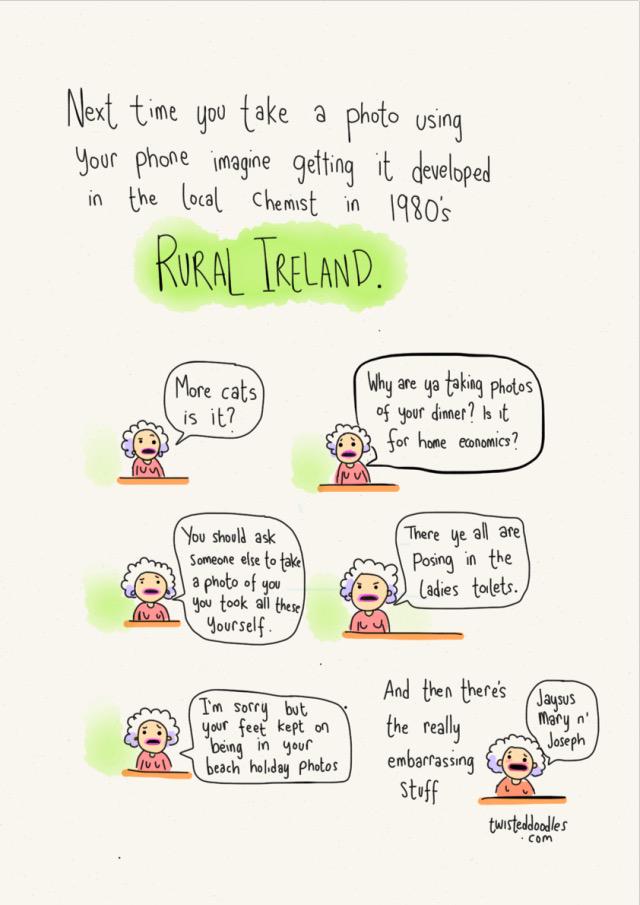Photography and social change
The doodle below might no be considered an infography proper, but it nevertheless contains a lot of interesting information about how the #social role of photography has changed, enabled by technology. Its title is “Next time you take a photo using your phone imagine getting it developed in the local chemist in 1980’s rural Ireland” (Thanks to @twisteddoodles, to be found here: twisteddoodles.com).

It is a well known story that Kodak was the company that first invented digital photography in 1975. And being it the leading manufacturer of film and developing equipment, Kodak chose to ignore the technology. Then came the new digital cameras. Kodak went belly up. Polaroid as well. Then came the iPhone and the world was changed forever. Our relationship with the camera and its social function was never to be the same. Gone were the days when kids got a Brownie for Christmas and were told only take photos of things that really mattered. Film, developing and printing were so expensive and not to be wasted.
More Cats Is It?
Understandably no kid in her or his right mind would think of taking pictures of the cat sleeping, or in any situation whatsoever. But how this is different now. The web is full with pictures and videos of cats, and the derived lolcats, of course. Nobody seems to be able to stop taking photos of cats, and posting online. Who cares? It costs nothing. And so it has become a part of our efforts to document every trivial aspect of our private life and share it with the wider world. Imagine just how the grumpy lady in the chemist store in the 80’s would have watched in disbelief when developing a film with 36 frames of a cat!
Tonight’s Dinner Photography
Same goes for food and drink pics. It would have been a rare sight in the 80’s to see somebody in a restaurant or at home taking pictures of the food in every stage of consumption. Were it not a performance art project or something. Today we are used to participate, via digital photography and social networks, in the minutiae of the eating and drinking habits of our friends. This new behavior is attached to the tantalizing possibility to mass-communicate not only our tastes, but also our travels, cosmopolitanism, enjoyment, daring and romances.
And, the Selfie
How difficult it is to understand our world without the pervasive selfie. A new practice that would have seemed more than just strange in the 80’s. But, the technical possibilities of our cameras have regaled us with a new way to stage ourselves. Forget the days of the bothersome delayed shutter and running to be in the picture. And today, not only appearance and clothing are fit for staging, also companionship, courting and locations. It is a running self-produced documentary of one’s life. More than this, the selfie is the window into our constant self-promotion. And it has rightfully become a new art form of portraiture.
Jaysus, Mary n’ Joseph!
And then there is of course the impact of change in the very private sphere, which has also become the victim of serialized documentation. There is the practice of homemade pornography, of course. But also the misuse of photos that were not meant for public viewing. With this also comes the abuse of private photos, and the bullying and exposure that goes with it.
It is really impressive how such an apparently small change in technology has spawned whole new businesses, and has provoked a permanent change in how we see ourselves and others see us. We are just starting to grasp the complete social impact of such changes. However, the enormous photographic record of our time will be an endless trove of research material for future generations.
What Do You Think?
Please leave you comments below, contact me or sign up for the mailing list!
Recommended reading
- Berger John. About Looking, Vintage, 1992.
- Sontag, Susan. On Photography, Picador, 2001.
- Barthes, Roland. Camera Lucida. Reflections on Photography, Hill and Wang, 2010.
- Storr, Will. Selfie: How We Became So Self-obsessed and What It’s Doing to Us, Overlook Press, 2018.





